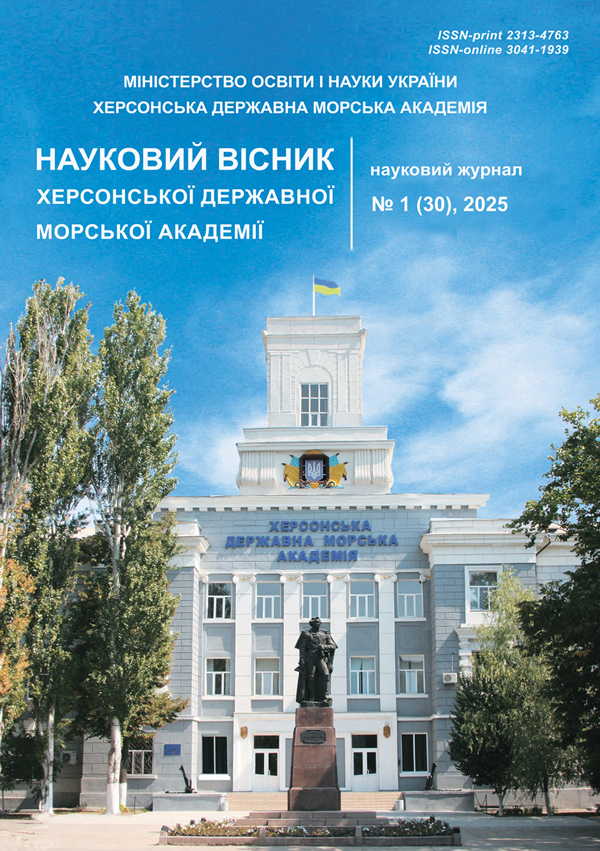COLLECTIVE CYBERSECURITY OF AUTONOMOUS MARITIME VESSELS BASED ON DECENTRALIZED INTELLIGENT ANALYSIS
https://doi.org/10.33815/2313-4763.2025.1.30.006-015
Abstract
This paper presents a comprehensive approach to enhancing the collective cybersecurity of autonomous maritime platforms through the integration of intelligent data analysis methods, decentralized coordination mechanisms, and a custom hybrid architecture that combines Long Short-Term Memory (LSTM) neural networks with onboard large language models (LLMs). The core innovation lies in augmenting traditional LSTM-based anomaly detection with LLM-driven semantic interpretation of navigational inconsistencies — a fundamentally novel strategy for self-governing maritime environments.
Particular attention is paid to the detection, explanation, and decentralized coordination of responses to Global Positioning System (GPS) spoofing attacks, which pose a significant threat to navigational accuracy, operational safety, and the overall coherence of fleet activities. The proposed system, built on a proprietary LSTM-LLM configuration, equips each vessel with multi-level cognitive capabilities: real-time anomaly detection, natural language generation of contextual explanations, and autonomous formulation of strategic responses without dependence on centralized oversight or communication infrastructure.
Unlike conventional centralized solutions, the system empowers each vessel to independently analyze situational data, derive human-understandable contextual insights, and adapt its behavior accordingly. The architecture includes a lightweight protocol for structured message exchange in JavaScript Object Notation (JSON) format, enabling efficient, resilient, and secure inter-vessel communication. Additionally, a decentralized consensus mechanism, based on a dynamically updated trust matrix, enhances the fleet’s robustness against partial compromise and improves operational integrity.
The effectiveness of the proposed approach is demonstrated through a simulated GPS spoofing scenario involving one compromised vessel within a five-vessel fleet. The results confirm the system’s ability to detect anomalies accurately, isolate the compromised unit, and successfully adapt the navigational strategies of the remaining vessels — thus maintaining uninterrupted mission continuity despite active cyber disruption.
References
2. Balduzzi, M., Pasta, A., & Wilhoit, K. (2014). A security evaluation of AIS automated identification system. In Proceedings of the 30th Annual Computer Security Applications Conference (ACSAC '14) (pp. 436–445). Association for Computing Machinery. https://doi.org/10.1145/2664243.2664257.
3. Androjna, A., Brcko, T., Pavic, I., & Greidanus, H. (2020). Assessing cyber challenges of maritime navigation. Journal of Marine Science and Engineering, 8(10), 776. https://doi.org/10.3390/jmse8100776.
4. Svilicic, B., Rudan, I., Jugović, A., & Zec, D. (2019). A study on cyber security threats in a shipboard integrated navigational system. Journal of Marine Science and Engineering, 7(10), 364. https://doi.org/10.3390/jmse7100364.
5. Greydanus, S. (2017). Using LSTM encoder-decoder algorithm for detecting anomalous ADS-B messages. arXiv.org. https://arxiv.org/abs/1711.10192.
6. Chen, J., Guo, D., Yao, Q., et al. (2024). Sustainable LLM inference for edge AI: Evaluating quantized LLMs for energy efficiency, output accuracy, and inference latency. arXiv preprint. https://arxiv.org/abs/2403.15971.
7. Khan, F., & Tomsett, R. (2024). Optimizing RAG techniques for automotive industry PDF chatbots: A case study with locally deployed Ollama models. arXiv preprint. https://arxiv.org/abs/2403.18931.
8. Tian, Z., Wang, S., Zhang, J., & Li, J. (2022). Cybersecurity risk assessment of unmanned surface vehicles. Ocean Engineering, 248, 110766. https://doi.org/10.1016/j.oceaneng.2022.110766.
9. Luo, Y., & Yu, F. R. (2021). Anomaly detection in autonomous systems using LSTM neural networks. IEEE Transactions on Industrial Informatics. https://doi.org/10.1109/TII.2020.3039102.
10. Bommasani, R., Hudson, D. A., et al. (2021). On the opportunities and risks of foundation models. Center for Research on Foundation Models (Stanford University). https://crfm.stanford.edu/report.html.
11. Cyber-MAR Project Consortium. (2022). Cyber range simulation for maritime cybersecurity training. Cyber-MAR Project. https://cyber-mar.eu.
12. Zinchenko, S. M., & Lyashenko, V. G. (2017). Usage of neural network model of the ship for control tasks. Scientific Bulletin of KSMA, 2(17), 231–237. http://journals.ksma.ks.ua/nvksma/article/view/587/524.
13. Kozachok, Y. A. (2024). Automation of information system architecture design for utility payments processing using artificial intelligence. Tavriyskyi Scientific Bulletin. Series: Technical Sciences, (2), 62–72. https://doi.org/10.32782/tnv-tech.2024.2.6.
14. Kozachok, Y. A., & Zinchenko, S. M. (2025). Integration of ChatGPT for decision support in autonomous ships in real-time mode. Scientific Bulletin of Kherson State Maritime Academy, (2), 111–121. http://journals.ksma.ks.ua/nvksma/article/view/889/903.
15. Tarelko, Wieslaw & Rudzki, Krzysztof. (2020). Applying artificial neural networks for modelling ship speed and fuel consumption. Neural Computing and Applications. 32. https://doi.org/10.1007/s00521-020-05111-2.






